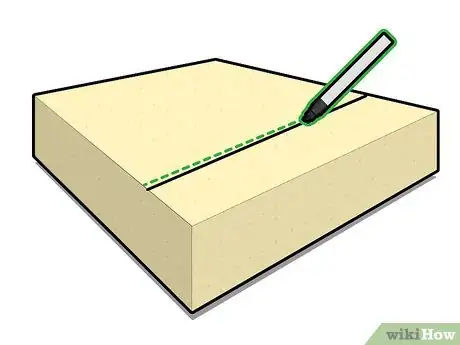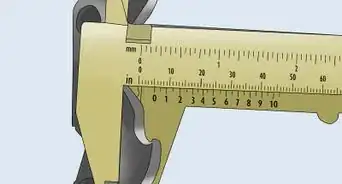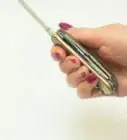wikiHow is a “wiki,” similar to Wikipedia, which means that many of our articles are co-written by multiple authors. To create this article, volunteer authors worked to edit and improve it over time.
This article has been viewed 36,159 times.
Learn more...
Commercial foam shops rely on cutting tools called foam saws. Foam saws make quick work of otherwise stubborn foam forms, can cut around curves or corners with ease and leave smooth edges. Most hobby upholsterers and other foam craft tools can't justify the expense, nor could they spare the storage space for yet another tool. Instead of raiding your rainy day fund for a tool that costs a few hundred dollars, use an electric carving knife. This foam saw alternative's long, serrated blade makes clean, professional grade cuts at a fraction of the expense.
Steps
-
1Draw your pattern onto the foam using a permanent marker. If you plan to wrap the foam with batting for a pillow or other upholstery project, subtract an inch from all sides for each layer of batting you'll use.
- Draw the pattern again on the underside of the foam section you'll cut.
-
2Place your marked foam block along the edge of a table, with the first marked line you want to cut overlapping the table's edge by about an inch.
- Lay a 1-inch (2.54-centimeters) thick plywood strip, which is as long as your tabletop and about 2-feet (.6096-meters) wide, over the foam block. Line it up the plywood's long section with the table's edge that's beneath the foam.
- Attach C-clamps to the plywood and the underside of the table on either side of the foam block.
- Tighten the clamps to hold the foam in place while you cut it.
Advertisement -
3Lubricate both sides of your electric carving knife's blade with a non-stick cooking spray. A lubricated blade cuts more easily and overheats less often than a dry blade, which helps you avoid injuries or cutting mistakes from forcing the knife.
- Turn on the knife and insert the tip of its blade into one of your pattern lines at a perpendicular angle until the knife has reached the underside of the foam block; do not cut further yet. Switch off the knife.
- Check beneath the knife to make sure it emerged on the underside pattern lines you marked.
- Turn the knife back on and start cutting; continue to hold your electric knife at a perpendicular angle for the duration of the cut to keep your cuts' edges straight. Allow the knife to glide gently along the foam's insides instead of applying too much pressure. Apply a gentle up-and-down sawing motion when necessary.
-
4Continue cutting without pause, for the remainder of the line's length. Stopping mid-cut usually creates a jagged or rippled cut in the area where you ended and re-started the cut. Approach square corners slowly, and place a framing square against the corner to help guide your cuts.
Community Q&A
-
QuestionCan I use the kitchen knife to cut food after cutting foam?
 Community AnswerNo, you can not unless you wash the knife first.
Community AnswerNo, you can not unless you wash the knife first.
Warnings
- When used as a foam saw alternative, electric knives can give you clean results inexpensively, but, like foam saws and other power cutting tools, the electric knife's blade can cause serious injuries if used carelessly. Never cut towards your hand, and don't struggle with or force the knife if you hit a tough spot.⧼thumbs_response⧽
- Stand in front of the overlapped edge instead of to its side so you can cut in front of yourself, from side to side, instead of towards yourself.⧼thumbs_response⧽
- Avoid using dull bladed electric knives, which you are more likely to need to more force.⧼thumbs_response⧽
Things You'll Need
- Foam block
- Permanent marker
- Table
- Plywood strip
- C-clamps
- Electric cutting knife
- Cooking oil spray
- Framing square
References
- http://books.google.com/books?id=gKHUfcw_zGwC&pg=PA20&dq=cut+foam+with+an+electric+knife&hl=en&ei=cTyeTd_0MYfLgQegjrnFDw&sa=X&oi=book_result&ct=result&resnum=2&ved=0CEYQ6AEwAQ - v=onepage&q=cut%20foam%20with%20an%20electric%20knife&f=false
- http://books.google.com/books?id=e9lWKrj4_JUC&pg=PA77&dq=cut+foam+with+an+electric+knife&hl=en&ei=cTyeTd_0MYfLgQegjrnFDw&sa=X&oi=book_result&ct=result&resnum=1&ved=0CEEQ6AEwAA#v=onepage&q=cut%20foam%20with%20an%20electric%20knife&f=false
- http://books.google.com/books?id=u4uTj3k9gr0C&pg=PA88&dq=cut+foam+with+an+electric+knife&hl=en&ei=cTyeTd_0MYfLgQegjrnFDw&sa=X&oi=book_result&ct=result&resnum=8&ved=0CGQQ6AEwBw - v=onepage&q=cut%20foam%20with%20an%20electric%20knife&f=false


























































